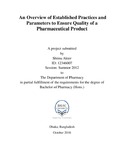An overview of established practices and parameters to ensure quality of a pharmaceutical product

View/
Date
2017-10-07Publisher
BRAC UniversityAuthor
Akter, ShimuMetadata
Show full item recordAbstract
The quality of a pharmaceutical product is one of the most challenging considerations of the pharmaceutical industry because it is directly related to the patient health and safety. Every pharmaceutical product should be manufactured by a licensed pharmaceutical manufacturer according to the guidelines, which should be stringently monitored by the licensed pharmacist, in order to attain the target quality product. The guidelines that are followed in the pharmaceutical industry are several, such as the ICH guideline, WHO guideline, FDA guideline, etc.
A systematic approach needs to be designed and developed with the ‘end’ in mind, in order to ensure quality where the product and process performance characteristics are scientifically designed to meet specific objectives, not merely empirically derived from performance of test batches. The impact of starting raw materials and process parameters on product quality must surely be well understood, with an emphasis on product and process understanding and process control. All processes involved must be continually monitored, evaluated, documented and updated in line with the ‘quality by design’ approach to allow for consistent quality throughout product life cycle.
The aim of the study was to highlight the various approaches and steps involved, and other relevant considerations that a pharmaceutical company must undertake, whether manufactured in-house or by outsourcing, in order to ensure product quality through ‘quality by design’ approach.
